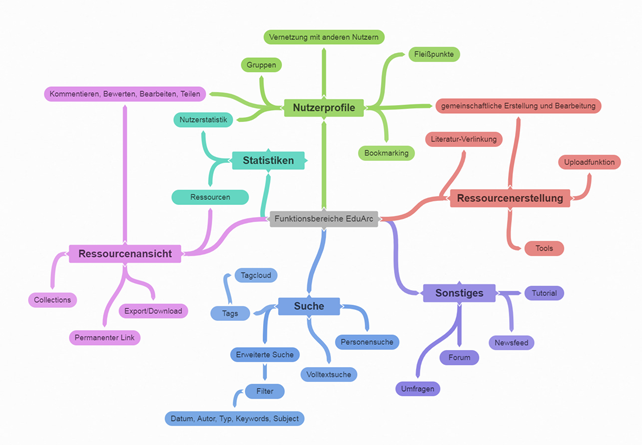Mind map – Essential functions

Digital Education Architecture
Open learning resources in distributed learning Infrastructures – EduArc
State of the art
In order to realize the potential of digitization for higher education, a cross-university digital ecosystem is needed that provides digital educational resources for distributed use (see M Kerres & Heinen, 2015). The BMBF feasibility study by Blees et al. (2016) on the infrastructure for open educational resources has shown for the higher education sector: There is an increasing amount of digital content on learning platforms and there are technologies available to provide this via repositories. What is needed is a solution that is based on a networked, federated infrastructure of decentralized repositories (see Heinen al., 2016) and that makes targeted use of open educational resources.
Digital educational architectures must thus relate to the digital research infrastructure, in particular to the infrastructures for literary and research data and research data management, and the associated developments in the scientific information and librarianship (under the keyword “open science”). take into account (see Siegfried, 2017). For example, the Information Infrastructure Council (RfII) has issued recommendations to the GWK on the development of a national research data infrastructure. Since 2016, the DFG has been funding the Generic Research Data Infrastructure (GeRDI) project, which is developing a model for a distributed infrastructure. A federal infrastructure for research data in education is funded by the BMBF project “Verbund Forschungsdaten Bildung (VFDB)”. At European level, the High Level Expert Group on the European Science Cloud (EOSC) deals with similar issues. Furthermore, the GOFAIR initiative aims to treat research data fairly, which was initiated by the BMBF and the Ministry of Science of the Netherlands. Similar to BW, Berlin and other federal states, the Digital University NRW has commissioned the planning of a subsidized infrastructure, through which open educational resources of the universities are made available and distributed.
Project overview
The project is developing a proven design concept for distributed learning infrastructures that will federate digital educational resources and other study-related information. It explores the technical, didactic and organizational conditions of an educational architecture that results from the networking of the digital infrastructure of universities and the interaction of state, public and private actors. It brings together distributed systems through open standards and interfaces, and is open to integrate future content providers and users. The announced architecture is to be interpreted for open as well as not openly licensed (references to) resources, because in teaching also perspectively different license variants will be relevant and expedient.
The project focuses on the challenges posed by the dissemination of openly licensed educational resources (OER / CC licenses) in an “informationally open ecosystem”. Depending on the license, these can be used, commented on and edited by teachers and students free of charge , mixed and made available again on the net, which opens up special didactic opportunities for higher education (Heinen et al., 2016). At the same time there are technical-conceptual challenges in the provision of OER, but also in access to distributed repositories, especially in dealing with edits and versions, the return of user-generated data to the author of the OER, and the resulting quality mechanisms for reputation acquisition ( for authors) and quality assurance (for resources).
Methodical approach and interdisciplinary cooperation
The project pursues a design-oriented research approach in which design concepts are developed with prototypes and field trials. The type and intensity of use is recorded on the basis of (anonymised) objective data (behavioral traces), in addition to online questionnaires and guideline-based interviews with which the various groups of users are asked about their experiences and assessments.
First of all, the universities represented by the actors function as pilot universities. In addition to the spatial and organizational proximity to the applicants, predecessor projects of the applicants to the universities provide infrastructures in various stages of development, which can be used as the basis for a distributed learning infrastructure. On the basis of preparatory work, a dataset is defined that defines success parameters at various levels (technical, didactic, organizational) in order to be able to record the impact of the project and to verify the achievement of the objectives.
Literature
- Blees, Ingo, Hirschmann, Doris, Kühnlenz, Axel, Rittberger, Marc, Schulte, Jolika, Cohen, Nadia, … Khenkitisack, Phoutsada. (2016). Machbarkeitsstudie zum Aufbau und Betrieb von OER-Infrastrukturen in der Bildung. Frankfurt: Deutsches Institut für Internationale Pädagogische Forschung.
- Drachsler, H., Verbert, K., Santos, O. C., & Manouselis, N. (2015). Panorama of Recommender Systems to Support Learning. In F. Ricci, L. Rokach, & B. Shapira (Hrsg.), Recommender Systems Handbook (S. 421–451). Springer, Boston, MA.
- Euler, D., Hasanbegovic, J., Kerres, M., & Seufert, S. (2006). Handbuch der Kompetenzentwicklung für eLearning Innovationen: Eine Handlungsorientierung für innovative Bildungsarbeit in der Hochschule. Bern: Huber.
- Kerres, M. (2015). E-Learning vs. Digitalisierung der Bildung: Neues Label oder neues Paradigma? In A. Hohenstein & K. Wilbers (Hrsg.), Handbuch E-Learning. Köln: Deutscher Wirtschaftsdienst.
- Kerres, M., Getto, B., & Kunzendorf, M. (2010). RuhrCampusOnline: Strategische Hochschulkooperation in der Universitätsallianz Metropole Ruhr. Zeitschrift für Hochschulentwicklung, 5.
- Kerres, M., & Heinen, R. (2015). Open informational ecosystems: The missing link for sharing resources for education. Interna- tional Review of Research in Open and Distributed Learning, 16.
Funding: BMBF
